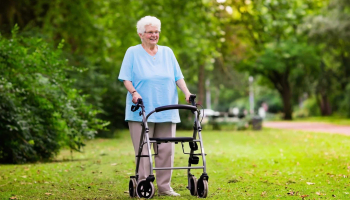Before our physiotherapist Kelvin James recommends an assistive walking aid for his patients, there is an assessment that he does to make sure that the aid is going to not only be safe but will also be effective. It would serve no purpose if the walking aid were going to bring a hell lots of problems to the patient such as pressure sores, bad posture, body discomfort and strain.
In this article, we go through a checklist of the things that he investigates before giving a go-ahead that a patient uses a certain walking aid.
Patient history
Kelvin must investigate the history of the client, know what condition they are suffering from, how long have they been suffering so as to know the right equipment to recommend. Conditions that could have the patient get a walking aid include Alzheimer’s dementia, ALS, arthritis, stroke, or Parkinson’s.
Is the patient taking medication to help them with balance or stability?
Have they had accidental falls before using some other walking aid?
Does the patient require external help from a caregiver to perform basic tasks such as going to the washroom, getting out of bed, or showering?
Is the patient craving for independence so that they do not have to always call out for someone to help them go to the toilet?
Do they have episodes of gait freezing such that they would require some sensory cues such as laser light or beeps from a metronome so that they can be prompted to walk ahead?
Is the condition that the patient is suffering from deteriorating or are they coming off it?
Walking cane assessment
- With age comes bending. Kelvin must assess the age of the patient so as to see what cane height the client needs.
- Your elbow should bend at a comfortable angle while you are still holding your cane
- Your arm should dangle free with your wrist lining to the head of the cane.
Wheelchair assessment
Do you have previous pressure sores or are they at risk of having pressure sores?
Signs that show that a patient might develop pressure sores from too much sitting on a wheelchair seat include: redness of the skin around the bottom and carves, moisture from sweat or incontinence, poor posture and excess weight. Incidences of pressure sores can be prevented by having a cushion seat.
Walking test
Kelvin instructs the patient to take the 6-minute test. The test involves having the patient walking on a straight track for six minutes. They can walk as far as possible. They might also rest if they feel like doing it. But all these are recorded. When this walk is ended, Kelvin will have noticed whether the patient really does need a walking aid and what type would be appropriate.
Of course, for non-ambulatory patients who will end up on wheelchairs or motorized scooters, this is not going to be possible. But it is okay for those who will be issued with walking canes or standard walkers.
Terrain used
Kelvin also must put the home terrain that the patient uses into perspective. To do this, he has to visit the patient at his home and see things from there.
How is the ground?
Where most does the client spend time?
How far are the washrooms from where the patient sits mostly?
Where is the bed from where the patient is at most times?
Is the terrain friendly for a walking stick, standard walker, rollator or motorized scooter?








